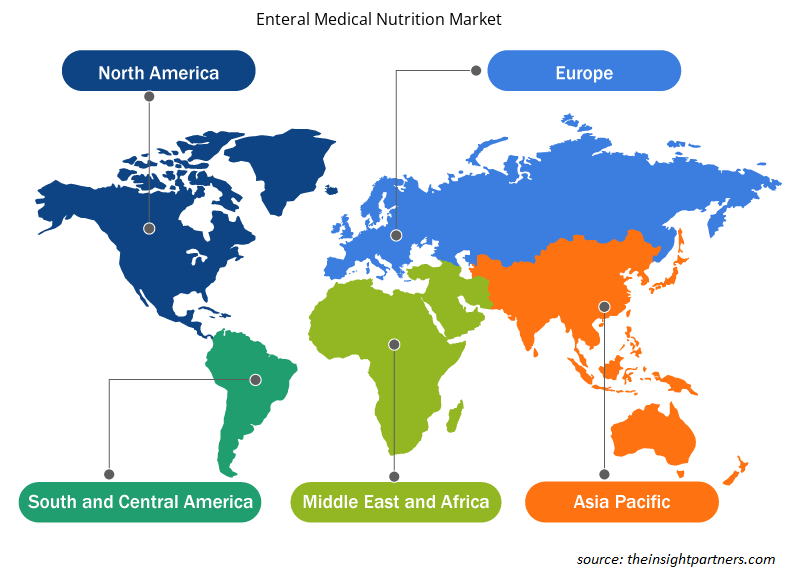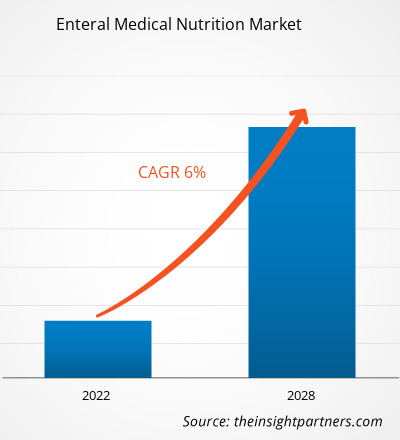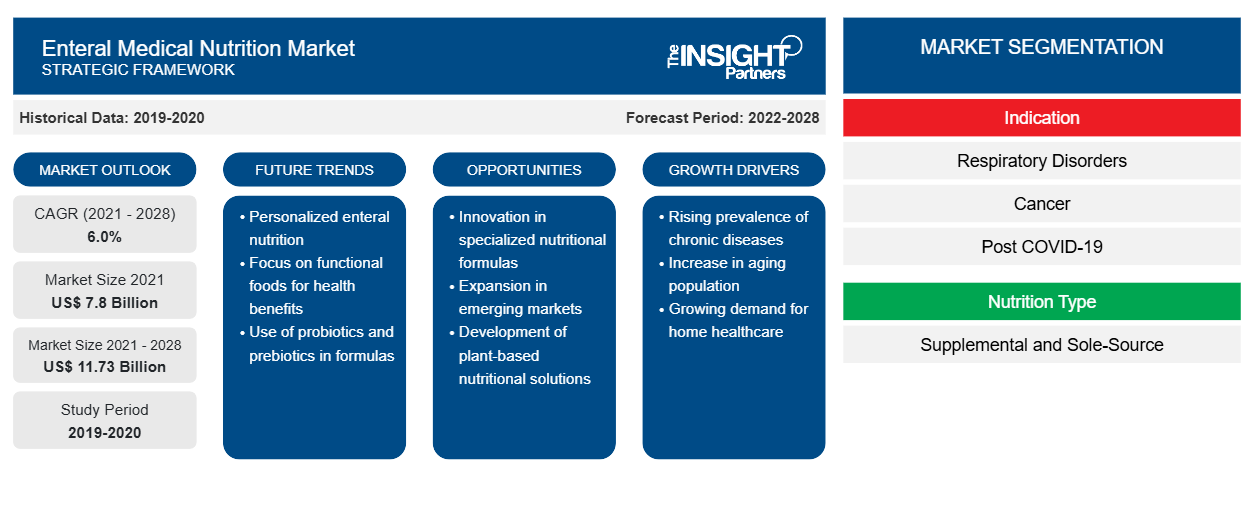Se proyecta que el mercado de nutrición médica enteral alcance los US$ 11.726,37 millones para 2028 desde los US$ 7.803,45 millones en 2021; se espera que crezca a una CAGR del 6,0% entre 2022 y 2028.
La nutrición enteral (NE) se proporciona a pacientes cuyas necesidades energéticas y nutricionales no pueden satisfacerse con una ingesta regular de alimentos. Las ventajas de la ingesta enteral sobre la nutrición parenteral son bien conocidas. Para la mayoría de los pacientes pediátricos que dependen de la nutrición enteral, una fórmula polimérica estándar adaptada a la edad enriquecida con fibras es una opción adecuada.
El mercado de nutrición médica enteral está segmentado en función de la indicación, el tipo de nutrición, la forma, el producto, el canal de distribución, el grupo de edad y la geografía. Por geografía, el mercado está ampliamente segmentado en América del Norte, Europa, Asia Pacífico, Oriente Medio y África, y América del Sur y Central. El informe ofrece información y un análisis profundo del mercado, haciendo hincapié en parámetros como las tendencias y la dinámica del mercado, y el análisis competitivo de los principales actores del mercado a nivel mundial.
Personalice este informe según sus necesidades
Obtendrá personalización en cualquier informe, sin cargo, incluidas partes de este informe o análisis a nivel de país, paquete de datos de Excel, así como también grandes ofertas y descuentos para empresas emergentes y universidades.
-
Obtenga las principales tendencias clave del mercado de este informe.Esta muestra GRATUITA incluirá análisis de datos, desde tendencias del mercado hasta estimaciones y pronósticos.
Perspectivas del mercado
Aumento de la prevalencia de caquexia
La caquexia es una enfermedad multifuncional que causa pérdida extrema de peso, pérdida de músculo esquelético y tejido adiposo, desequilibrio de la regulación metabólica y reducción de la ingesta de alimentos. Es una consecuencia clínica grave de casi todas las enfermedades crónicas cuando alcanzan etapas avanzadas. Según NCBI (Centro Nacional de Información Biotecnológica), en 2016, la prevalencia de caquexia osciló entre el 5 y el 15% en la insuficiencia cardíaca crónica terminal. Ocurre con frecuencia en pacientes que padecen enfermedad renal crónica, enfermedad pulmonar obstructiva crónica (EPOC) , enfermedad neurológica y artritis reumatoide . Las tasas de mortalidad de los pacientes con caquexia varían del 15 al 25% por año en pacientes con EPOC grave y del 20 al 40% por año en pacientes con insuficiencia cardíaca crónica o enfermedad renal crónica.
La caquexia por cáncercachexia afecta negativamente la calidad de vida de los pacientes con cáncer y reduce la eficacia de la quimioterapia contra el cáncer y aumenta su toxicidad, lo que conduce al aumento de la mortalidad relacionada con el cáncer y el gasto de recursos médicos. Según Globocan, la Organización Mundial de la Salud informó de 9,6 millones de muertes y 18,1 millones de nuevos casos de cáncer en 2018. Además, la caquexia por cáncer es un síndrome de desgaste que se presenta en hasta el 80% de los pacientes con cáncer. Según el artículo publicado por el Departamento de Medicina Pulmonar y de Cuidados Intensivos de Pekín, la prevalencia de la caquexia es del 87% en pacientes con cáncer de páncreas y estómago; del 61% en pacientes con cáncer de colon, pulmón y próstata; y de ~40% en pacientes con cáncer de mama, sarcoma, leucemia y linfoma de Hodgkin. Además, el 20% del total de muertes relacionadas con el cáncer se deben a la caquexia. En la caquexia, los nutrientes del cuerpo disminuyen. Por lo tanto, es necesario proporcionar nutrientes externos para continuar el tratamiento del cáncer y la EPOC. Los médicos prefieren la vía enteral para proporcionar estos nutrientes necesarios al paciente. Por lo tanto, la creciente prevalencia de la caquexia debido a la creciente incidencia de diversas enfermedades crónicas impulsa el crecimiento del mercado de la nutrición médica enteral. Globocan, World Health Organization reported 9.6 million deaths and 18.1 million new cancer cases in 2018. In addition, cancer cachexia is a wasting syndrome that occurs in up to 80% of cancer patients. According to the article published by Department of Pulmonary and Critical Care Medicine, Beijing, the prevalence of cachexia is 87% in pancreatic and gastric cancer patients; 61% in colon, lung, and prostate cancer patients; and ~40% in breast cancer, sarcoma, leukemia, and Hodgkin lymphoma patients. In addition, 20% of the total cancer-related deaths are due to cachexia. In cachexia, the nutrients in the body decrease. Therefore, it is necessary to provide external nutrients to continue the treatment for cancer and COPD. Doctors prefer enteral route to provide these required nutrients to the patient. Therefore, growing prevalence of cachexia due to the rising incidence of various chronic diseases fuels the growth of the enteral medical nutrition market.
Información sobre indicaciones
Según las indicaciones, el mercado de nutrición médica enteral se segmenta en trastornos respiratorios, cáncer, post COVID-19, trastornos gastrointestinales, insuficiencia hepática y otros. El mercado del segmento de trastornos respiratorios se segmenta aún más en enfermedad pulmonar obstructiva crónica (EPOC), insuficiencia respiratoria, fibrosis quística y otros. El mercado del segmento de cáncer se subsegmenta en caquexia por cáncer, caquexia con EPOC y otros. El mercado del segmento de trastornos gastrointestinales se segmenta aún más en obstrucción intestinal, obstrucción del intestino corto, enfermedad de Crohn y otros. El segmento de trastornos respiratorios tuvo la mayor participación de mercado en 2021. Sin embargo, se anticipa que el segmento de cáncer registre la CAGR más alta del mercado del 7,6% durante el período de pronóstico. Pulmocare fabricado por Abbott está diseñado para personas que padecen EPOC, fibrosis quística o insuficiencia respiratoria. La fórmula enteral alta en calorías, carbohidratos y grasas modificados puede ayudar a estos pacientes a reducir la producción de dióxido de carbono inducida por la dieta.COPD), respiratory failure, cystic fibrosis, and others. The market for the cancer segment is subsegmented into cancer cachexia, cachexia with COPD, and others. The market for the gastrointestinal disorders segment is further segmented into bowel obstruction, short bowel obstruction, crohn’s disease, and others. The respiratory disorders segment held the largest market share in 2021. However, the cancer segment is anticipated to register the highest CAGR of 7.6% in the market during the forecast period. Pulmocare manufactured by Abbott is designed for people suffering from COPD, cystic fibrosis, or respiratory failure.
Información sobre el tipo de nutrición
Según el tipo de nutrición, el mercado mundial de nutrición médica enteral se bifurca en suplementaria y de fuente única. El segmento suplementario tuvo una mayor participación de mercado en 2021. Sin embargo, se prevé que el segmento de fuente única registre una CAGR más alta durante el período de pronóstico. Los pacientes que reciben la fuente suplementaria de nutrición están sujetos a permanecer en el hospital durante un período prolongado. Se proporcionan a los pacientes fórmulas enterales enriquecidas con ácidos grasos omega-3, ácidos ribonucleicos y glutamina o arginina. Por ejemplo, Jevity es una fórmula nutricional diseñada para proporcionar nutrición suplementaria o de fuente única para adultos que están en regímenes de alimentación por sonda a corto o largo plazo. La misma está disponible en densidades calóricas de 1,0, 1,2 y 1,5 calorías por mililitro. Las fórmulas Jevity también pueden ayudar a satisfacer las necesidades diarias de proteínas y fibra de los pacientes.
Información sobre formularios
Según la forma, el mercado mundial de nutrición médica enteral se segmenta en polvo, líquido y semisólido. El segmento semisólido tuvo la mayor participación de mercado en 2021 y se prevé que registre la CAGR más alta durante el período de pronóstico.
Información sobre el producto
Según el producto, el mercado mundial de nutrición médica enteral se segmenta en dieta proteica estándar, dieta alta en proteínas, nutrientes orales a base de jugo de frutas y otros. El segmento de dieta proteica estándar tuvo la mayor participación del mercado en 2021. Sin embargo, se prevé que el segmento de nutrientes orales a base de jugo de frutas registre la CAGR más alta durante el período de pronóstico.
Información sobre el canal de distribución
Según el canal de distribución, el mercado de nutrición médica enteral se segmenta en farmacias hospitalarias, tiendas minoristas y otras farmacias. El segmento de farmacias hospitalarias tuvo la mayor participación del mercado en 2021. Sin embargo, se prevé que el segmento de tiendas minoristas registre la CAGR más alta durante el período de pronóstico.
Perspectivas sobre grupos de edad
Según la edad, el mercado de nutrición médica enteral se divide en niños (hasta 18 años) y adultos (18 años o más ). Los adultos (18 años o más ) tuvieron una mayor participación del mercado en 2021. Sin embargo, se prevé que el segmento de niños (hasta 18 años) registre una CAGR más alta durante el período de pronóstico.
Perspectivas regionales del mercado de nutrición médica enteral
Los analistas de Insight Partners explicaron en detalle las tendencias y los factores regionales que influyen en el mercado de nutrición médica enteral durante el período de pronóstico. Esta sección también analiza los segmentos y la geografía del mercado de nutrición médica enteral en América del Norte, Europa, Asia Pacífico, Oriente Medio y África, y América del Sur y Central.

- Obtenga datos regionales específicos para el mercado de nutrición médica enteral
Alcance del informe de mercado de nutrición médica enteral
| Atributo del informe | Detalles |
|---|---|
| Tamaño del mercado en 2021 | 7.800 millones de dólares estadounidenses |
| Tamaño del mercado en 2028 | US$ 11,73 mil millones |
| CAGR global (2021-2028) | 6.0% |
| Datos históricos | 2019-2020 |
| Período de pronóstico | 2022-2028 |
| Segmentos cubiertos |
Por indicación
|
| Regiones y países cubiertos |
América del norte
|
| Líderes del mercado y perfiles de empresas clave |
|
Densidad de actores del mercado de nutrición médica enteral: comprensión de su impacto en la dinámica empresarial
El mercado de nutrición médica enteral está creciendo rápidamente, impulsado por la creciente demanda de los usuarios finales debido a factores como la evolución de las preferencias de los consumidores, los avances tecnológicos y una mayor conciencia de los beneficios del producto. A medida que aumenta la demanda, las empresas amplían sus ofertas, innovan para satisfacer las necesidades de los consumidores y aprovechan las tendencias emergentes, lo que impulsa aún más el crecimiento del mercado.
La densidad de actores del mercado se refiere a la distribución de las empresas o firmas que operan dentro de un mercado o industria en particular. Indica cuántos competidores (actores del mercado) están presentes en un espacio de mercado determinado en relación con su tamaño o valor total de mercado.
Las principales empresas que operan en el mercado de nutrición médica enteral son:
- Laboratorios Abbott
- Nutricia
- Fresenius Kabi AG
- B. Braun Melsungen AG
- NESTLÉ SA
Descargo de responsabilidad : Las empresas enumeradas anteriormente no están clasificadas en ningún orden particular.

- Obtenga una descripción general de los principales actores clave del mercado de nutrición médica enteral
Mercado de nutrición médica enteral por región
Por geografía, el mercado global está segmentado en América del Norte (EE. UU., Canadá y México), Europa (Reino Unido, Alemania, Francia, Italia, España y el resto de Europa), Asia Pacífico (China, Japón, India, Australia, Corea del Sur y el resto de Asia Pacífico), Medio Oriente y África (EAU, Arabia Saudita, Sudáfrica y el resto de Medio Oriente y África) y América del Sur y Central (Brasil, Argentina y el resto de América del Sur y Central).
Perfiles de empresas
Abbott Laboratories; Nutricia; Fresenius Kabi AG; B. Braun Melsungen AG; NESTLE SA; Meiji Holdings Co., Ltd.; Smartfish AS; DSM; Hormel Foods Corporation; y Global Health Products, Inc. se encuentran entre los principales actores del mercado de nutrición médica enteral.
- Análisis histórico (2 años), año base, pronóstico (7 años) con CAGR
- Análisis PEST y FODA
- Tamaño del mercado, valor/volumen: global, regional y nacional
- Industria y panorama competitivo
- Conjunto de datos de Excel
Informes recientes
Informes relacionados
Testimonios
Razón para comprar
- Toma de decisiones informada
- Comprensión de la dinámica del mercado
- Análisis competitivo
- Información sobre clientes
- Pronósticos del mercado
- Mitigación de riesgos
- Planificación estratégica
- Justificación de la inversión
- Identificación de mercados emergentes
- Mejora de las estrategias de marketing
- Impulso de la eficiencia operativa
- Alineación con las tendencias regulatorias























 Obtenga una muestra gratuita para - Mercado de nutrición médica enteral
Obtenga una muestra gratuita para - Mercado de nutrición médica enteral